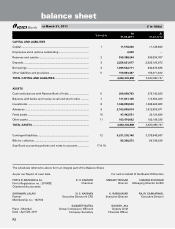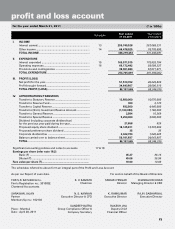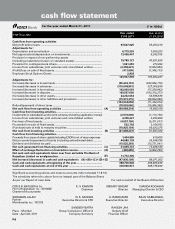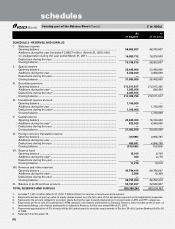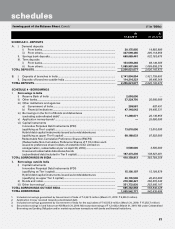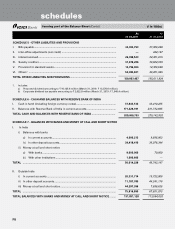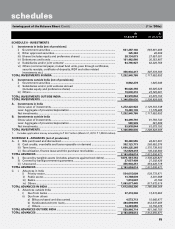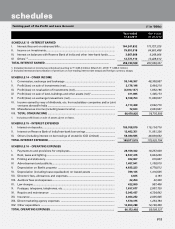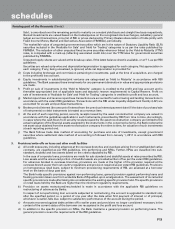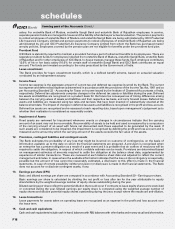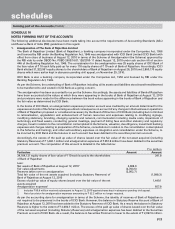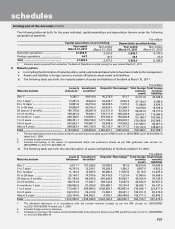ICICI Bank 2011 Annual Report Download - page 90
Download and view the complete annual report
Please find page 90 of the 2011 ICICI Bank annual report below. You can navigate through the pages in the report by either clicking on the pages listed below, or by using the keyword search tool below to find specific information within the annual report.
F12
SCHEDULE 17
Significant accounting policies
OVERVIEW
ICICI Bank Limited (ICICI Bank or the Bank), incorporated in Vadodara, India is a publicly held banking company engaged in
providing a wide range of banking and financial services including commercial banking and treasury operations. ICICI Bank is
a banking company governed by the Banking Regulation Act, 1949.
Basis of preparation
The financial statements have been prepared in accordance with requirements prescribed under the Third Schedule of the
Banking Regulation Act, 1949. The accounting and reporting policies of ICICI Bank used in the preparation of these financial
statements conform to Generally Accepted Accounting Principles in India (Indian GAAP), the guidelines issued by Reserve
Bank of India (RBI) from time to time, the Accounting Standards (AS) issued by the Institute of Chartered Accountants of India
(ICAI) and notified by the Companies (Accounting Standards) Rules, 2006 to the extent applicable and practices generally
prevalent in the banking industry in India. The Bank follows the accrual method of accounting, except where otherwise stated,
and the historical cost convention.
The preparation of financial statements requires the management to make estimates and assumptions which are considered
in the reported amounts of assets and liabilities (including contingent liabilities) as of the date of the financial statements
and the reported income and expenses during the reporting period. Management believes that the estimates used in the
preparation of the financial statements are prudent and reasonable. Future results could differ from these estimates.
SIGNIFICANT ACCOUNTING POLICIES
1. Revenue recognition
a) Interest income is recognised in the profit and loss account as it accrues except in the case of non-performing assets
(NPAs) where it is recognised upon realisation, as per the income recognition and asset classification norms of RBI.
b) Income from hire purchase operations is accrued by applying the implicit interest rate to outstanding balances.
c) Income from leases is calculated by applying the interest rate implicit in the lease to the net investment outstanding
on the lease over the primary lease period. Leases entered into till March 31, 2001 have been accounted for as
operating leases.
d) Income on discounted instruments is recognised over the tenure of the instrument on a constant yield basis.
e) Dividend is accounted on an accrual basis when the right to receive the dividend is established.
f) Loan processing fee is accounted for upfront when it becomes due.
g) Project appraisal/structuring fee is accounted for on the completion of the agreed service.
h) Arranger fee is accounted for as income when a significant portion of the arrangement/syndication is completed.
i) Commission received on guarantees issued is amortised on a straight-line basis over the period of the guarantee.
j) All other fees are accounted for as and when they become due.
k) Net income arising from sell-down/securitisation of loan assets prior to February 1, 2006 has been recognised
upfront as interest income. With effect from February 1, 2006, net income arising from securitisation of loan assets
is amortised over the life of securities issued or to be issued by the special purpose vehicle/special purpose entity
to which the assets are sold. Net income arising from sale of loan assets through direct assignment with recourse
obligation is amortised over the life of underlying assets sold and net income from sale of loan assets through direct
assignment, without any recourse obligation, is recognised at the time of sale. Net loss arising on account of the
sell-down/securitisation and direct assignment of loan assets is recognised at the time of sale.
l) The Bank deals in bullion business on a consignment basis. The difference between price recovered from customers
and cost of bullion is accounted for at the time of sales to the customers. The Bank also deals in bullion on a
borrowing and lending basis and the interest paid/received is accounted on accrual basis.
2. Investments
Investments are accounted for in accordance with the extant RBI guidelines on investment classification and valuation
as given below.
a) All investments are classified into ‘Held to Maturity’, ‘Available for Sale’ and ‘Held for Trading’. Reclassifications,
if any, in any category are accounted for as per RBI guidelines. Under each classification, the investments are further
categorised as (a) government securities, (b) other approved securities, (c) shares, (d) bonds and debentures,
(e) subsidiaries and joint ventures and (f) others.
b) ‘Held to Maturity’ securities are carried at their acquisition cost or at amortised cost, if acquired at a premium over
the face value. Any premium over the face value of fixed rate and floating rate securities acquired is amortised over
the remaining period to maturity on a constant yield basis and straight line basis respectively.
c) ‘Available for Sale’ and ‘Held for Trading’ securities are valued periodically as per RBI guidelines. Any premium
over the face value of fixed rate and floating rate investments in government securities, classified as ‘Available for
forming part of the Accounts (Contd.)
schedules


